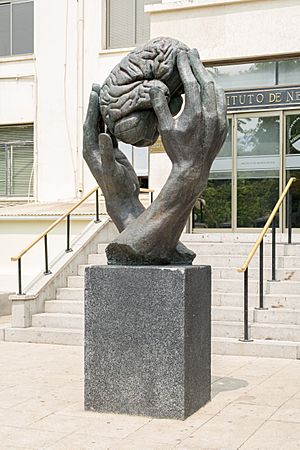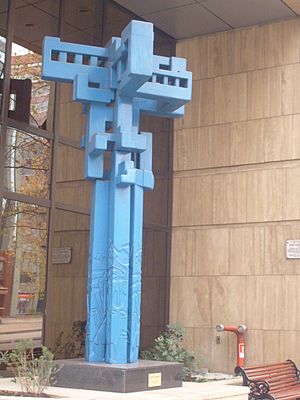Marta Colvin facts for kids
Quick facts for kids
Marta Colvin Andrade
|
|
|---|---|
 |
|
| Born | 1907 Chillán, Chile
|
| Died | 27 October 1995 (aged 87–88) Santiago, Chile
|
| Nationality | Chilean |
| Education | Universidad de Chile |
| Known for | Sculpture |
Marta Colvin Andrade (1907–1995) was a famous sculptor from Chillán, Chile. She was known for creating amazing art pieces, often using natural materials like wood and stone. Her sculptures can be found in many places around the world, showing her unique style and talent.
About Marta Colvin
Marta Colvin Andrade was born in 1907. After a big earthquake hit her hometown of Chillán in 1939, she moved to Santiago, Chile. There, she studied art at the School of Arts.
Marta became an assistant professor in sculpture in 1943. She learned from well-known artists like Julio A. Vasquez and Lorenzo Domínguez. By 1950, she was officially a professor.
In 1948, she traveled to Paris, France, to study at the Grande Chaumiere Academie. She learned from famous sculptors Ossian Zadkine and Henry Laurens. Marta lived in France for over thirty years, creating many beautiful artworks.
She became known all over the world for her talent. In 1965, she took part in the first Sao Paulo Biennale, a big art exhibition. In 1970, she received the National Art Prize in Chile. This award recognized her amazing sculptures and her contributions to art.
Marta Colvin passed away in Santiago on October 27, 1995. Her art continues to inspire people today.
Famous Sculptures
Marta Colvin created many important sculptures. Her works are displayed in museums and public spaces around the world. She often used materials like bronze, wood, and stone.
Here are some of her well-known sculptures:
- Silvia (1946): A bronze sculpture found in the Santiago Museum of Contemporary Art.
- Danza para tu sombra (1952): A granite sculpture at the General Santiago Cemetery.
- Homenaje a la Neurocirugía (1953): A tall bronze sculpture at the Instituto de Neurocirugía in Santiago.
- Eslabón (1956): A sculpture made of sycamore wood, located in the Museo Nacional de Bellas Artes in Santiago.
- Quinchamalí (1956): A wooden sculpture found in the Marta Colvin Sculpture Park in Chillán.
- Manutara (1957): A bronze sculpture displayed in Battersea Park, London.
- Terra Mater (1957): A wooden sculpture at the Pinacoteca de la Universidad de Concepción.
- Andes (1959): A bronze sculpture at the Palais du Quirinal in Rome.
- Signo solar / Grand Signe (1963): A large stone sculpture in the Musée de la sculpture en plein air in Paris.
- Mural de Osaka (1970): A sculpture made of stone and copper at the Museum of Osaka.
- Puerta del Sol (1970): A red Andes stone sculpture at the Museum of Pontoise.
- Señal del bosque / Signal en forêt (1971): A large wooden sculpture in the Forest of Sénart.
- El árbol de la vida (1971): A stone sculpture at the Centro Cultural Gabriela Mistral in Santiago.
- Caleuche (Nef) (1975): An Andes stone sculpture at the port of Saint-Nazaire.
- Léviathan (1977): A large wooden sculpture in Outreau, France.
- Espíritu del agua (1982): A bronze sculpture in the Plaza del General de Gaulle, Marly-le-Roi.
- Vigía del mar (1983): A granite sculpture at Fort Crozon, Brest, France.
- Madre Tierra / Pachamama (1986): A red Andes stone sculpture at the Museo Parque de las Esculturas de Santiago.
- Himno al trabajo (1989): A colorful wooden sculpture at the Cámara Chilena de la Construcción in Santiago.
- Señal de oriente y occidente / Signal (1991): A colorful wooden sculpture in the Sculpture park of Séoul.
- Alas al viento: A stone sculpture at the University of Talca sculpture park.
- Monumento a Sucre: Located in Plaza Sucre, Ñuñoa, Santiago.
See also
 In Spanish: Marta Colvin para niños
In Spanish: Marta Colvin para niños




